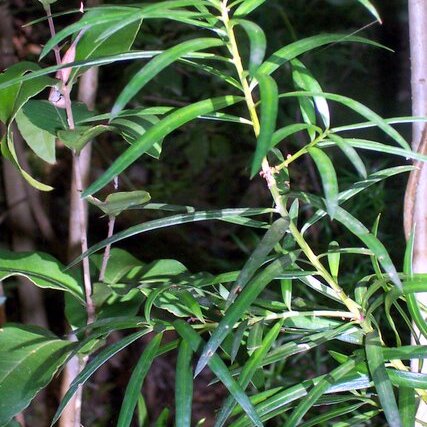Shrub to 3 m tall, often lax and spreading. Bark thin, fibrous. Resting leaf buds conica, 2-4 mm long, 1.5-3 mm diam.; scales narrowly triangular, with fine, spreading tips. Adult leaves linear, subsessile, 2-6.5 cm long, 2-4.5 mm wide, acuminate, glossy green; midrib narrow, slightly raised above, prominent below; 1 resin duct present below vascular bundle; upper hypodermis interrupted. Male cones broadly cylindrical, 4-8 mm long, 2-4 mm diam., axillary in groups of 1-5 on a peduncle 1-3 mm long; microsporophylls imbricate, obtuse, finely apiculate. Female cones of 1 fertile scale with 1 (or 2) ovules, axillary on peduncles 4-10 mm long; receptacle 6-10 mm long, fleshy, purple at maturity, subtended by 2 deciduous bracts 1-4 mm long. Mature seed ovoid, 8-15 mm long, 7-10 mm diam., often crested.
More
A pine. It is a medium sized shrub. It grows 0.7-3 m high and spreads 1.5-4 m wide. The branches can lie along the ground. They sometimes root at the nodes. They are often long and slender. The leaves are thick textured and dark green and glossy above but paler underneath. They are 1.5-8 cm long by 0.2-0.4 cm wide. They are alternate and spreading. The new leaves are pale. The leaves have sharp points. The male cones are 0.4-0.8 cm long and in the axils of leaves. They are in clusters. The female cone usually occurs singly. It has one or two seeds. These are on the end of bluish-black fleshy stems.


